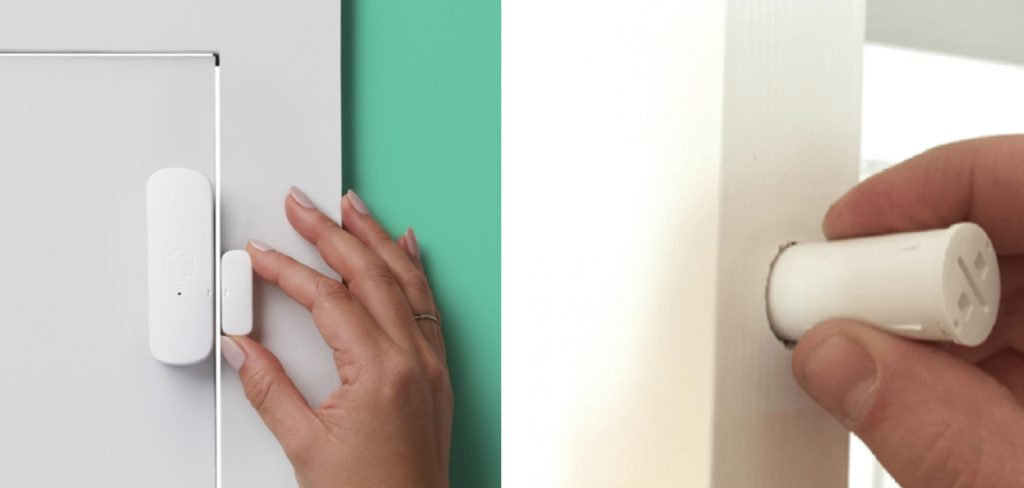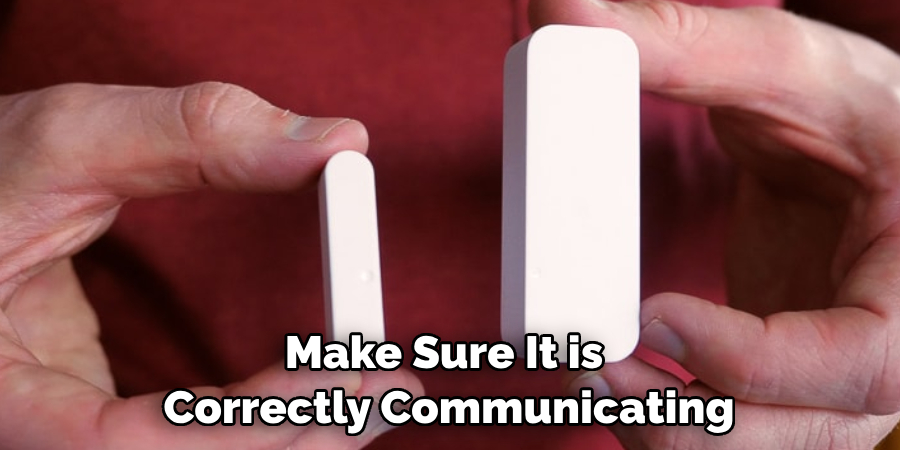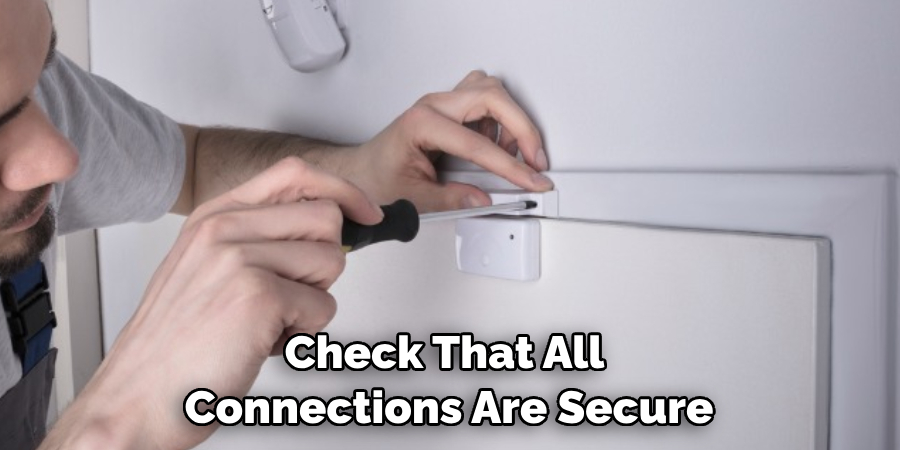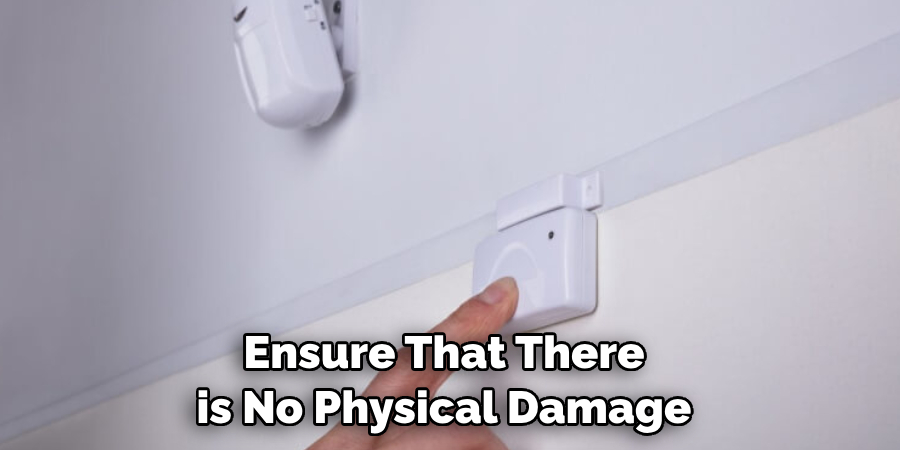Are you looking for an easy and affordable way to protect your home from intruders? Installing a recessed door alarm sensor can be a great security measure. Not only is it fairly simple to install, but it allows you to get alerted anytime someone opens the door without your permission.

In this blog post, we’ll show you how to install recessed door alarm sensor in no time! From gathering all of the tools and supplies needed for installation to performing the actual steps required, we have everything covered so that you can rest easy knowing that your home is secure.
Tools and Materials You Will Need to Install Recessed Door Alarm Sensor
- Recessed Door Alarm Sensor (depending on the size of the door, you may need two)
- Screws
- Drill
- Tape Measure
- Leveler
- Pencil
Step-by-step Guidelines on How to Install Recessed Door Alarm Sensor
Step 1: Mark the Installation Spot
Before you begin drilling holes in your wall or door, take out a tape measure and leveler and measure the size of the door. Next, mark the spot on the door where you want to install the alarm sensor using a pencil. Make sure that both sensors are aligned perfectly on opposite sides of the door (or one if it’s a smaller-sized door).
Step 2: Drill Holes

Once all markings have been made, use your drill to create two small holes in the door (or one if it’s a smaller-sized door). Make sure the hole size is just large enough to fit the screws for the alarm sensors. While drilling, make sure that the holes are level with each other. You don’t want any of the screws to be crooked!
Step 3: Install the Alarm Sensor
Now that you have made all of your holes, it’s time to install the alarm sensors. Insert the screws into each hole before tightening them with a screwdriver. Once both screws are secure, attach the alarm sensor with two small screws and then connect it to your doorbell or home security system. Make sure that all connections are secure and the alarm sensors are functioning properly before moving on.
Step 4: Test the Alarm Sensor
Finally, test out the alarm sensor by opening and closing the door. Make sure that it is set up correctly and responding to movement as desired. If everything looks good, you can rest easy knowing that your home is now protected. Make sure to keep the door locked at all times for added security!
We hope you found this guide on how to install a recessed door alarm sensor helpful. Installing an alarm sensor can be a great way to ensure your home is kept safe and secure from any unwanted visitors. Be sure to follow our step-by-step guidelines for best results and peace of mind!
Additional Tips and Tricks to Install Recessed Door Alarm Sensor
1. Make sure that the door has been correctly prepped. To ensure the installation is successful, the door should be free of any paint or debris and smoothed out to an even surface.
2. Utilize a power drill to make the necessary hole for your sensor. This will help ensure that you are able to get a perfect fit for your alarm sensor.
3. Place your alarm sensor inside the hole and use screws to secure it in place. Make sure that the contact points are fully aligned with the edges of the door.
4. Connect your alarm sensor to your home security system using appropriate wiring from the manufacturer. This will ensure reliable performance when detecting motion inside or outside of the house.

5. Test your alarm sensor to make sure it is correctly communicating with the security system. You can do this by opening and closing the door or triggering a motion detector to test its responsiveness.
6. Remember to calibrate your alarm sensor as necessary after installation. This will help ensure that you are able to get the most accurate readings when detecting motions inside or outside of the house.
7. Make sure to clean and maintain your alarm sensor regularly in order to keep it functioning at its best. Cleaning the contact points can help reduce false alarms due to debris or dust buildup over time.
Following these tips and tricks can help make sure that you have a successful installation of your recessed door alarm sensor. With the right tools and know-how, you can get your home security system up and running in no time!
Things You Should Consider to Install Recessed Door Alarm Sensor
1. Determine your needs for the recessed door alarm sensor. Depending on the security system you are using, different sensors may be needed for optimal efficiency and accuracy.
2. Select a power source to provide energy to the sensors. Most recessed door alarm sensors require either a battery or an AC line connection as the power supply source.
3. Mark out the area on the door where you want to install the sensor. Make sure there is no obstruction in the way of the detector that might interfere with its performance.
4. Drill a hole in the door frame, making sure it’s large enough for both sensors and wires to fit through.
5. Attach the recessed door alarm sensor to both sides of the door using screws.

6. Connect the sensor’s wires to the power source and check that all connections are secure and correctly wired.
7. Test your alarm system to make sure it is functioning properly with the recessed door alarm sensor installed.
8. Properly seal any gaps between the sensors and door frame with caulking or weather stripping, to prevent any drafts or moisture from entering.
9. Lastly, check the alarm system regularly and replace the batteries as needed in order to ensure its proper functioning.
By following these considerations, you can install a recessed door alarm sensor confidently and securely. This will ensure that your home or business is protected from intruders. With the right tools and supplies, you’ll be able to complete this project in no time!
Precautions Need to Follow for Installing Recessed Door Alarm Sensor
1. Make sure that you have read the instructions carefully and understand how to install the recessed door alarm sensor before proceeding.
2. It is better to remove any existing fixtures in an area where you plan to install the sensor.

3. Ensure that there is no physical damage or lack of maintenance to the door, wall, and ceiling before installing the alarm system.
4. Also, make sure there is a power outlet near the device so that it can be connected properly.
5. Check if the system has all its components and mounting accessories for successful installation.
6. In order to prevent any damages, make sure that the ceiling and wall fixtures are appropriate for the installation of the recessed door alarm sensor and can handle the weight.
7. Keep in mind that when you install a recessed door alarm sensor, it is important to maintain proper alignment with the walls and ceilings of your home or office.
Following these precautions will help you ensure that your recessed door alarm sensor is properly installed and will work correctly. With the right installation, your home or office will be secure and protected from any unwanted intruders. When completed, test the alarm to make sure it works as expected. If any problems are encountered, contact a professional for assistance in resolving them.
Frequently Asked Questions
Is Professional Installation Required?
While a professional installer is not necessary, it may be beneficial to have one with more experience and knowledge when installing your recessed door alarm sensor. This will ensure that the job is done correctly and can help to make sure that there are no potential issues down the road. Additionally, a professional installer may be able to provide advice on the placement of the sensor and other components for optimal performance.
What Are the Benefits of an Alarm Sensor?

Installing a recessed door alarm sensor provides several benefits such as added security for your home or business. With the sensor installed, you can be sure that any unauthorized entry is immediately detected and alerted. Additionally, a recessed door alarm sensor can help deter potential intruders from entering by alerting others in the area of their presence. Finally, it may even help reduce insurance costs as some companies offer discounts for having an alarm system installed.
What Kind of Maintenance Does a Recessed Door Alarm Sensor Require?
Once installed, you can rest assured that your recessed door alarm sensor will require minimal maintenance. This includes regularly checking the batteries and making sure there are no obstructions blocking the sensor. Additionally, it is important to keep the sensors clean as dust and dirt may affect their performance.
Do I Need to Buy Additional Accessories?
No additional accessories are required when installing a recessed door alarm sensor, though there are optional ones you can purchase to enhance the system’s capabilities.
For example, some people choose to add additional sensors or motion detectors that will detect any movement within the area of the home or business. Additionally, you may want to consider adding a camera or other visual deterrents for added security.
Conclusion
With the above outlined you can learn how to install recessed door alarm sensor in your home or business. You do not need to hire a professional, but it may be beneficial for more experienced advice and troubleshooting. Additionally, you should note the benefits of having an alarm sensor such as added security, deterring potential intruders, and reducing insurance costs.
Finally, you should expect minimal maintenance requirements such as checking batteries and making sure there are no obstructions. With the right equipment and knowledge, you can ensure that your home or business is properly protected.
About
Safety Fic is a distinguished figure in the world of Diy design, with a decade of expertise creating innovative and sustainable Diy solutions. His professional focus lies in merging traditional craftsmanship with modern manufacturing techniques, fostering designs that are both practical and environmentally conscious. As the author of diy, Safety Fic delves into the art and science of Safety Fic-making, inspiring artisans and industry professionals alike.
Education RMIT University
(Melbourne, Australia) Associate Degree in Design (Safety Fic) Focus on sustainable design, industry-driven projects, and practical craftsmanship. Gained hands-on experience with traditional and digital manufacturing tools, such as CAD and CNC software.
Nottingham Trent University
(United Kingdom) Bachelor’s in diyfastly.com and Product Design (Honors) Specialized in product design with a focus on blending creativity with production techniques. Participated in industry projects, working with companies like John Lewis and Vitsoe to gain real-world insights.
Publications and Impact
In diy, Safety Fic his insights on indoor design processes, materials, and strategies for efficient production. His writing bridges the gap between artisan knowledge and modern industry needs, making it a must-read for both budding designers and seasoned professionals.
